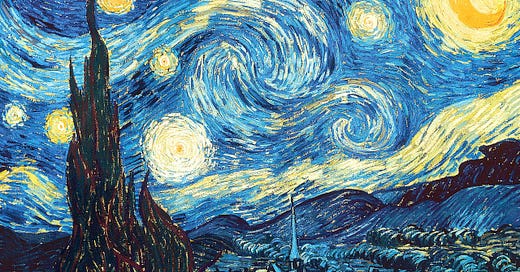How The Starry Night became a brand—but is it still art?
Has Van Gogh’s most famous painting lost its meaning in a sea of tote bags and t-shirts?
There are some paintings that exist quietly, waiting to be admired. And then there’s The Starry Night. It doesn’t just sit there, it feels alive in a way paintings aren’t supposed to feel, like it’s trying to tell you something.
Maybe that’s why it’s everywhere. On tote bags and phone cases, dorm room posters and museum walls. It’s a painting that has transcended art history, that has slipped into pop culture so seamlessly that we forget to stop and really look at it.
But if you do so, you’ll see it’s more than just a pretty night sky. It’s chaos. It’s longing. It’s a storm that lives inside a quiet, desperate mind.
It’s Van Gogh himself.
The Madness in the Paint
Here’s something a lot of people don’t realize: The Starry Night wasn’t painted in some dreamy, peaceful moment of artistic inspiration. It wasn’t a reflection of the night sky he admired from a balcony in Paris.
No.
It was painted in an asylum.
Saint-Paul-de-Mausole, to be exact. A psychiatric hospital in France, where Van Gogh admitted himself after a mental breakdown.
And that’s what makes The Starry Night so different from all the other landscapes and cityscapes and soft, beautiful impressions of the world. It wasn’t painted from life. It was painted from inside. A reflection of a mind that couldn’t quite find peace.
Look at the sky again. The stars don’t sit calmly in place. They swirl, twist, pulse with movement. The clouds aren’t soft. They are waves, crashing through the air like a sea in the sky. Even the moon seems to glow unnaturally bright, as if it’s pressing against the canvas, trying to escape.
And yet, below it all, the town sits still. Silent. Asleep.
A world at peace while the universe above it rages on.
A mind that cannot rest, even as everything else does.
The Loneliness of a Genius
Van Gogh never saw success in his lifetime. He sold only one painting while he was alive. One.
But now? His name is everywhere. His works are worth millions. His brushstrokes are studied and admired and replicated endlessly.
But imagine this: at the time of painting The Starry Night, Van Gogh was isolated, suffering, convinced his art would die with him.
And in a way, The Starry Night is a perfect metaphor for that.
A painting that no one truly noticed at first.
A masterpiece born in a moment of pain.
A night sky that rages on, even as the world below it sleeps.
Why The Starry Night Still Matters
We live in a world that moves way too fast for anyone’s liking. Art has been commercialized, turned into products, into trends, into things we scroll past without a second thought. But some works carry the weight of the people who created them, the emotions they poured into the canvas, the things they couldn’t quite say out loud.
The Starry Night is one of those.
So next time you see it—on a mug, a t-shirt, a museum wall—don’t just glance.
Stop.
Look.
And try to see it the way Van Gogh must have seen it. Not just as a night sky, but as everything he was trying so desperately to say.
Final Thoughts
I definitely think some art is meant to be admired, and some meant to be felt.
But this one? This one is both!
So, what do you think? More like this? A different artist, another piece of art that deserves a second look? Let me know—I love creating these!




